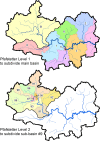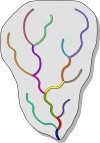Global hydro-environmental sub-basin and river reach characteristics at high spatial resolution
- PMID: 31819059
- PMCID: PMC6901482
- DOI: 10.1038/s41597-019-0300-6
Global hydro-environmental sub-basin and river reach characteristics at high spatial resolution
Abstract
The HydroATLAS database provides a standardized compendium of descriptive hydro-environmental information for all watersheds and rivers of the world at high spatial resolution. Version 1.0 of HydroATLAS offers data for 56 variables, partitioned into 281 individual attributes and organized in six categories: hydrology; physiography; climate; land cover & use; soils & geology; and anthropogenic influences. HydroATLAS derives the hydro-environmental characteristics by aggregating and reformatting original data from well-established global digital maps, and by accumulating them along the drainage network from headwaters to ocean outlets. The attributes are linked to hierarchically nested sub-basins at multiple scales, as well as to individual river reaches, both extracted from the global HydroSHEDS database at 15 arc-second (~500 m) resolution. The sub-basin and river reach information is offered in two companion datasets: BasinATLAS and RiverATLAS. The standardized format of HydroATLAS ensures easy applicability while the inherent topological information supports basic network functionality such as identifying up- and downstream connections. HydroATLAS is fully compatible with other products of the overarching HydroSHEDS project enabling versatile hydro-ecological assessments for a broad user community.
Conflict of interest statement
The authors declare no competing interests.
Figures





References
-
- Green PA, et al. Freshwater ecosystem services supporting humans: pivoting from water crisis to water solutions. Global Environ. Change. 2015;34:108–118. doi: 10.1016/j.gloenvcha.2015.06.007. - DOI
Publication types
Grants and funding
LinkOut - more resources
Full Text Sources

